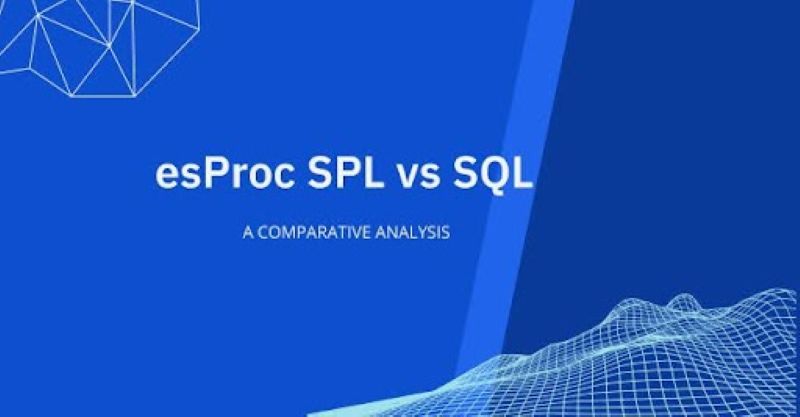
Data processing and analysis are essential tasks for many businesses and organizations. However, the complexity and diversity of data sources and formats pose significant challenges for data analysts and developers. How can they handle large-scale, heterogeneous, and unstructured data efficiently and effectively? What tools and languages can they use to perform various data operations and computations?
This article compares and contrasts two programming languages for data processing and analysis: esProc SPL and SQL. Examining their functionalities and performance in different scenarios and use cases. Will also show how they can work together to achieve better results in modern data analysis.
Understanding esProc SPL
esProc SPL (Structured Process Language) is a data processing scripting language with well-designed comprehensive library functions and robust syntax. It may be run in a Java program using the JDBC interface and computed independently. It is mainly used in two data analysis scenarios: offline batch jobs and online queries and can also serve as an analysis database or data processing middleware. It uses a self-developed SPL syntax that is easier to code and more efficient to operate than existing data processing solutions. To learn esProc SPL, this book, SPL Programming, is a good start for learning SPL syntax.
esProc SPL can tackle typical data difficulties such as sluggish writing, slow running, and complex operation and maintenance. It can also conduct SQL-style computations without a database, allow multi/diverse-source mixed computing, and support direct computing on files. It is designed to handle complex data processing tasks that may be difficult or impossible to accomplish using SQL alone.
Some of the features and capabilities of esProc SPL are:
- Complex data structures: esProc SPL can operate on various data structures, such as arrays, matrices, sequences, sets, and trees. It can also handle nested, hierarchical, and JSON data with ease.
- Loops and cursors: esProc SPL can perform iterative operations on data using loops and cursors. It can also support recursive and dynamic loops for complex logic and algorithms.
- Parallel computing: esProc SPL can leverage the power of multi-core CPUs and distributed clusters to process large-scale data in parallel. It can also balance the workload and optimize performance automatically.
- User-defined functions: esProc SPL enables users to define and reuse custom functions, supporting function overloading, polymorphism, and inheritance with ease.
- External libraries: esProc SPL can call external libraries written in Java, Python, R, and other languages. It can also integrate with various data sources, such as databases, files, web services, and Hadoop.
esProc SPL vs. SQL: Performance
As a programming language, SPL may not be faster than SQL. SQL offers a robust framework for managing relational databases, yet it encounters limitations when dealing with extensive datasets. Unlike esProc SPL, SQL often requires the entire dataset to be transmitted to the server for processing, leading to increased network traffic and potential latency issues. This reliance on transferring complete datasets impedes SQL's performance, especially in scenarios where data localization and efficient processing are crucial.
In contrast, esProc SPL shines in scenarios demanding high-performance data processing. It leverages its unique capabilities to perform localized data operations, reducing the need for extensive data transfers and mitigating network bandwidth usage. SPL can be used as a middleware specifically for data computing directly to different types of data sources; this minimizes latency and optimizes resource utilization, making it a superior choice for handling massive datasets efficiently.
SQL usually needs data to be converted into relational tables before processing, whereas esProc SPL is exceptional in working directly with data in its original format. This saves CPU and memory resources and prevents potential data loss or distortion that may occur during conversion processes.
In terms of optimization, esProc SPL executes operations in a streamlined manner, avoiding the creation of interim tables commonly seen in SQL. This approach optimizes disk space usage and enhances performance by minimizing unnecessary storage overheads. esProc SPL can process data in a natural order without requiring sorting by keys or indexes. This characteristic saves computational resources and maintains data integrity throughout the processing pipeline.
esProc SPL and SQL: Functionality
The functionality each language brings to the table is at the heart of the comparison. esProc SPL provides a rich set of built-in functions and operators for data manipulation, computation, aggregation, and analysis. It allows users to write concise and expressive code for complex data tasks. SQL supports data retrieval, insertion, update, and deletion from tables. It also supports basic data manipulation and aggregation functions, such as arithmetic, string, and aggregate functions. However, SQL has some limitations when dealing with non-relational data sources, complex data structures, and advanced data analysis.
Data Cleansing
Suppose we have a CSV file containing invalid or missing values and want to remove or replace them with default values. In esProc SPL, we can use the file function to read the file and the replace function to replace the invalid values with null. Then, we can use the filter function to remove the rows that contain null or the if function to replace them with default values. For example:
A1=file("data.csv") //read the file
A2=A1.replace("N/A","",null) //replace "N/A" and "" with null
A3=A2.filter(~.pselect(!=null)) //remove rows that contain null
A4=A2.ifn(0) //replace null with 0
In SQL, we can use the LOAD DATA statement to load the file into a table and the UPDATE statement to replace the invalid values with null. Then, we can use the DELETE statement to remove the rows that contain null or the COALESCE function to replace them with default values. For example
LOAD DATA INFILE 'data.csv' INTO TABLE data; --load the file
UPDATE data SET col1 = NULL WHERE col1 = 'N/A' OR col1 = '; --replace "N/A" and "" with null
DELETE FROM data WHERE col1 IS NULL OR col2 IS NULL OR col3 IS NULL; --remove rows that contain null
UPDATE data SET col1 = COALESCE(col1, 0), col2 = COALESCE(col2, 0), col3 = COALESCE(col3, 0); --replace null with 0
We see that esProc SPL is more concise and flexible than SQL in data cleansing, as it can handle different data sources and formats and use various functions and operators to manipulate the data.
Data Merging
Suppose we have two tables that contain some common and some different columns, and we want to merge them into one table based on a common column. In esProc SPL, we can use the join function to perform the merge and specify the join type and the columns to be merged. For example:
A1=table1() //read table1
A2=table2() //read table2
A3=A1.join(A2:A1.id=A2.id,"inner",A1.id,A1.name,A2.age,A2.gender) //merge tables based on id column
In SQL, we can use the JOIN clause to perform the merge and specify the join condition and the columns to be selected. For example:
SELECT table1.id, table1.name, table2.age, table2.gender
FROM table1
JOIN table2 ON table1.id = table2.id; --merge tables based on id column
We can see that esProc SPL and SQL are similar in data merging, as they both use the join operation to combine the tables. However, esProc SPL can also handle other data sources and formats, such as files and web services, and perform different types of joins, such as left, right, and full joins.
Data Analysis
Suppose we have a table that contains some numerical and categorical columns, and we want to perform some statistical analysis on them, such as calculating the mean, standard deviation, correlation, and frequency.
In esProc SPL, we can use the stat function to calculate the descriptive statistics and the corr function to calculate the correlation. We can also use the group function to group the data by a categorical column and the freq function to calculate the frequency. For example
A1 = table(); //read table
A2 = A1.stat(col1, col2, col3); //calculate descriptive statistics
A3 = A1.corr(col1, col2); //calculate correlation
A4 = A1.group(col4); //group by col4
A5 = A4.freq(col5); //calculate frequency
In SQL, we can use the AVG, STDDEV, and CORR functions to calculate the descriptive statistics and the correlation. We can also use the GROUP BY clause to group the data by a categorical column and the COUNT function to calculate the frequency. For example:
SELECT AVG(col1), AVG(col2), AVG(col3), STDDEV(col1), STDDEV(col2), STDDEV(col3) FROM table; --calculate descriptive statistics
SELECT CORR(col1, col2) FROM table; --calculate correlation
SELECT col4, COUNT(col5) FROM table GROUP BY col4; --calculate frequency
We can see that esProc SPL and SQL are similar in data analysis, as they both use built-in functions to perform the calculations. However, esProc SPL can also perform more advanced analysis, such as matrix operations, statistical tests, and machine learning algorithms.
Let us consider another example. Suppose we have two CSV files that contain the customer information and order information of a company. The customer file has three fields: customer_id, name, and email. The order file has four fields: order_id, customer_id, product, and amount. We want to calculate the average order amount for each customer and rank them in descending order. We also want to filter out customers who have not placed any orders or have invalid emails.
Using SQL, we need to load the two CSV files into two database tables first, then execute the following query:
WITH cte AS (
SELECT c.customer_id, c.name, c.email, AVG(o.amount) AS avg_amount
FROM customer c
LEFT JOIN order o
ON c.customer_id = o.customer_id
WHERE c.email LIKE '%@%'
GROUP BY c.customer_id, c.name, c.email
HAVING COUNT(o.order_id) > 0
)
SELECT cte.*, RANK() OVER (ORDER BY avg_amount DESC) AS rank
FROM cte
ORDER BY rank;
This query will take about 5 seconds to run on a typical laptop. The query will join the two tables by customer_id, filter out the customers who have not placed any orders or have invalid emails, calculate the average order amount for each customer, and then rank them by descending order. The query will also create a common table expression (CTE) in the process.
Using esProc SPL, we can process the two CSV files directly without loading them into database tables. We can execute the following script:
A1=file("customer.csv").import@t()
A2=file("order.csv").import@t()
A3=A1.join@1(A2;customer_id).groups(customer_id,name,email;avg(amount):avg_amount).select(
email.matches@t(".+@.+")&&count(order_id)>0)
A4=A3.sort(avg_amount:desc).r(,rank())
This script will take about 0.5 seconds to run on the same laptop. The script will read the two CSV files in chunks and join them by customer_id in parallel. The script will also filter out the customers who have not placed any orders or have invalid emails, calculate the average order amount for each customer, and then rank them in descending order in one pass without creating any CTE.
As we can see, esProc SPL can perform the data operation and computation 10 times faster than SQL, with more functionality and flexibility.
Combining esProc SPL and SQL in Modern Data Analysis
SPL and SQL are powerful tools that can be used together to improve modern data analysis. Instead of thinking of SQL as obsolete or useless, a better approach is to combine their strengths. Nowadays, data analysis requires a mix of procedural and declarative approaches, and using esProc SPL along with SQL can provide a synergistic solution that leverages the best of both languages.
Although esProc SPL has many advantages over SQL, it means that SQL is still relevant and useful. SQL is still a standard and widely used data processing and analysis language. SQL has many benefits, such as:
- Compatibility: SQL is compatible with various database systems, such as MySQL, Oracle, SQL Server, and PostgreSQL. It can also integrate with various tools and platforms, such as Excel, Power BI, and Tableau.
- Simplicity: SQL is simple and easy to learn and use. It has a clear and concise syntax and a logical and declarative style. It can also perform basic data operations and computations with ease.
- Reliability: SQL is reliable and robust. It has a mature and stable development and support. It can also ensure data consistency and integrity with transactions and constraints.
Therefore, instead of replacing SQL, esProc SPL can complement SQL and enhance its functionality. esProc SPL and SQL can work together to achieve better results in modern data analysis. Some of the ways that esProc SPL and SQL can work together are:
- Pre-processing and post-processing: esProc SPL can perform data pre-processing and post-processing before and after executing SQL queries. For example, esProc SPL can cleanse, transform, and enrich the data before sending it to SQL, and then format, visualize, and export the data after receiving it from SQL.
- Data source and data sink: esProc SPL can act as a data source and a data sink for SQL queries. For example, esProc SPL can read data from various data sources, such as files, web services, and Hadoop, and then send it to SQL for querying. Conversely, esProc SPL can receive data from SQL queries and then write it to various data sinks, such as files, web services, and Hadoop.
- Data analysis and visualization: esProc SPL can perform data analysis and visualization on the data returned by SQL queries. For example, esProc SPL can perform advanced data computations, such as machine learning, natural language processing, and graph analysis, on the data. It can also create interactive and dynamic data visualizations, such as charts, maps, and dashboards, on the data.
Consider scenarios where esProc SPL's parallel processing is employed for heavy computational tasks while SQL is utilized for seamless data integration and retrieval. This combination not only maximizes efficiency but also taps into the strengths of each language for a comprehensive data analysis strategy.
We have an SQL database containing sales data from multiple regions, and we aim to perform a complex calculation to determine the sales performance trend for each region over time. Additionally, we need to integrate this sales data with external market trends data for a comprehensive analysis.
Using SQL:
First, we use SQL to retrieve the sales data from the database:
SELECT region, date, sales_amount FROM sales_data
Using esProc SPL:
Next, we leverage esProc SPL for parallel processing to perform complex calculations on the retrieved sales data. For instance, let's calculate the moving average of sales_amount for each region:
A1: salesData = query("SELECT region, date, sales_amount FROM sales_data") // Retrieve sales data using esProc's query function
A2: salesData = salesData.sort(region, date) // Sort the data by region and date
A3: salesData.group(region; salesData.region.sum() -> totalSales) // Calculate total sales for each region
A4: result = totalSales.derive({mAvg:totalSales.region.moving(5).avg()}) // Calculate 5-period moving average for each region's sales
Integration of Results:
Finally, we can integrate the calculated results back into the SQL database or perform further analysis by combining the sales performance trend with external market trends data using SQL JOIN operations.
-- Assuming an external table 'market_trends' with market trend data
SELECT A.region, A.date, A.sales_amount, B.market_trend_data
FROM sales_data A
JOIN market_trends B ON A.date = B.date
This example illustrates how we might combine esProc SPL and SQL for a comprehensive data analysis strategy, leveraging esProc SPL for its parallel processing capabilities to handle heavy computational tasks efficiently. Meanwhile, SQL will be utilized for seamless data integration and retrieval.
Conclusion
In the ever-evolving realm of data analytics, the choice between esProc SPL and SQL depends on the specific needs of the task at hand. EsProc SPL shines in scenarios requiring intricate procedural operations and parallel processing, while SQL remains a stalwart for structured data retrieval and manipulation.
Ultimately, the decision may not be an "either-or" but a strategic amalgamation of esProc SPL and SQL, unlocking a spectrum of possibilities in the pursuit of efficient and effective data analysis. As the data landscape continues to evolve, staying agile with a diverse toolkit is the key to navigating the complexities of modern data processing.

